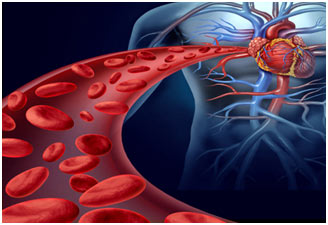The circulatory system of humans has 3 fundamental components.
- (A) Circulating fluid – the blood
- (B) The pumping organ – the heart.
- (C) The blood vessels, arteries, blood vessels, and veins.
In this tutorial, we will discuss the circulating fluid in bodies – The Blood.
The circulatory fluid – The blood
The blood is the medium in which dissolved nutrients, gases, hormones, and wastes are carried through the body. It is made up of two primary components, 1. Plasma and 2. cells or cell-like bodies (white blood cells, red cell, platelets). The weight of the blood in our body is 1/12th of our body.
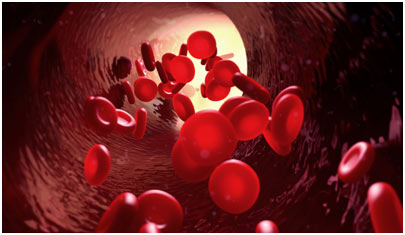
Plasma
It has actually been estimated that in a normal individual plasma constitutes about 55% by volume of the blood, and cells or cell-like bodies about 45% by volume of the blood.
Plasma is primarily water in which proteins, salts, nutrients and wastes are dissolved. Water constitutes about 90% of plasma, 10% are other dissolved substances. Most of the dissolved substances are preserved at a constant or nearly consistent level, but others occur in varying concentrations.
The substances dissolved or present in plasma vary in their concentrations, with the condition of the organism and with the part of the system under examination. The solutes can be divided into 6 groups:
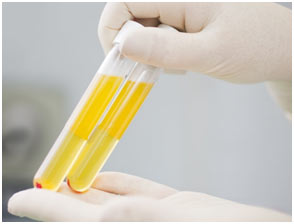
-
Inorganic ions or mineral ions:
Together the inorganic ions and salts make up 0.9% of the plasma, of humans, by weight; more than two-thirds of this quantity are sodium chloride the common table salt. Even if the total concentration of dissolved substances stays the exact same, shifts in the concentration of specific ion can produce severe disturbances. The normal pH of human blood is 7.4; and it is kept between narrow limits, due to the fact that the change in pH would affect the chemical reactions of the body.
-
The plasma proteins
The plasma proteins constitute 7-9 per cent by weight of the plasma. The majority of these proteins are synthesized in the liver. Some of the globulins, called immunoglobulins or antibodies, are produced in response to antigens, by lymphocytes; and after that are passed to plasma and lymph.
The proteins like prothrombin act as a catalyst in the blood clot process. Fibrinogen participates in the blood clotting procedure. Immunoglobulins play an essential role in the body’s defences against illness.
-
Organic nutrients
Organic nutrients in the blood consist of, glucose, fats, phospholipids, amino acids and lactic acids. A few of them enter the blood from the intestine (absorption). Lactic acid is produced in muscles as a result of glycolysis and is transported by the blood to the liver. Cholesterol is an essential constituent, it is metabolized to some extent, but also functions as a precursor of steroid hormonal agents.
- Plasma also consists of nitrogenous waste products formed as a result of cellular metabolism. These products are brought from the liver where they are produced to the organs from where they are removed i.e. kidneys. Urea and percentages of uric acid are present in plasma.
- All the hormonal agents in the body are carried by blood – so they are present in the plasma.
- The gases such as CO2, O2 are present in the plasma of the blood.
Blood Cells and Cell Like Bodies
These include red blood cell, (Erythrocytes), white blood cells (leucocytes) and platelets.
(a) Red blood cell (Erythrocytes)
These are the most numerous of the cells in the blood. A cubic millimetre consists of 5-1/2 million of them in males, and 4-1/2 million in females. These cells, when formed, have a nucleus, but it is lost prior to they enter the circulatory fluid or blood. 95% of the cytoplasm of red blood cells is the red pigment, called haemoglobin the remaining 5% consists of enzymes, salts and other proteins.
The red cells when grow, do not divide. Red blood cells are formed primarily at a bone marrow of short bones, such as the sternum, ribs and vertebrae. In the embryonic life, they are formed in the liver and spleen.
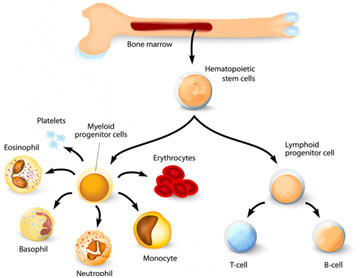
The typical life span of the red cell is four months after which it breaks down in the liver and spleen – partially by phagocytes by phagocytosis.
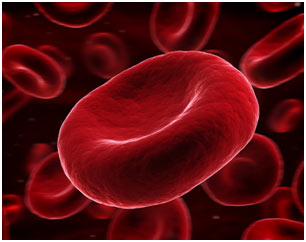
(b) White blood cell (Leucocytes)
These blood cells are colourless, as they do not contain pigments. One cubic millimetre of blood contains 7000 to 8000 of them. They are much larger than the red cell. There are at least five different types which can be distinguished on the basis of the shape of the nucleus and density of granules in the cytoplasm. They can be organized into two primary types, granulocytes and agranulocytes.
Granulocytes include neutrophils, eosinophils and basophils. They are formed in the red bone marrow. Agranulocytes are formed in lymphoid tissue, such as those of the lymph nodes, spleen, tonsils, adenoids and the thymus. Agranulocytes consists of monocytes and lymphocytes (B and T).
Monocytes remain from 10- 20 hours in the blood, then enter tissues and end up being tissue macrophages, performing the phagocytotic function. Lymphocytes have life spans of months or even years, but this depends upon the body’s requirement for these cells.
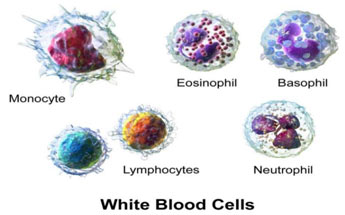
Leucocytes safeguard the body against foreign invaders and use the circulatory system to travel to the site of invasion. Monocytes and neutrophils move through capillaries and reach the site of injury where bacteria have actually gained entry. Macrophages and neutrophils eat bacterial intruders or other foreign cells, consisting of cancer cells. They normally die at the same time, and their dead bodies build up and add to the white substance called pus, seen at infection sites.
Basophils produce heparin – a substance that hinders blood clot. These also produce chemicals, such as histamine, that participate in allergies and in reactions to tissue damage and microbial invasion. Lymphocytes help to provide resistance versus the disease.
(c) Platelets
These are not cells but are fragments of big cells called megakaryocytes. There is no nucleus in them. There is no pigment in them. Platelets help in the conversion of fibrinogen, a soluble plasma protein, into insoluble kind, fibrin. The fibrin threads ensnare red blood cells and other platelets in the location of damaged tissue, eventually forming an embolism or blood clot. The clot works as a short-term seal to prevent bleeding until the harmed tissue can be repaired.
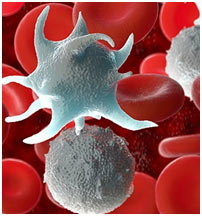
Functions of blood
The functions of blood in human beings can be listed as follows:
- i) The plasma proteins maintain colloid osmotic pressure of the blood (75% by albumins, 25% by globulins and nearly none by fibrinogen).
- ii) Blood helps to transport materials, in the body consisting of nutrients, water, salts and waste products. All hormones are transported by the blood from the endocrine tissues to the target cells.
- iii) Gases O2 and CO2 are transported by blood.
- iv) Blood helps in body defences against illness, neutrophils and monocytes swallow up and destroy germs, e.g. bacteria.
- v) Blood provides immunity by the lymphocytes.
- vi) Blood produces interferon, and antitoxins which are proteins, and protects our body from nucleic acids and toxins of invading organism.
- vii) Blood functions as a buffer to maintain the acid – base balance i.e. concentration of H+ and OH– ions of the body.
- viii) Assists in maintaining the body temperature level, the concentration of water and salts, thus assists in homeostasis.
- ix) Wall of Blood helps in the exchange of materials between blood and body tissue through blood capillaries via the interstitial fluid.
- x) Blood helps the body in maintaining the internal environment, by producing heparin, histamines, and likewise maintaining the amounts of chemicals including water and salts, in the body and maintains body temperature to a consistent or nearly constant level.
- xi) Helps in the blood clotting process and seals the wounds, that stop entry of pathogens into the body.
FAQs – Blood Circulatory System in Humans
1. What are the fundamental components of the human circulatory system?
- The circulatory system comprises three essential components: (A) Circulating fluid (blood), (B) The pumping organ (heart), and (C) Blood vessels (arteries, veins, and capillaries).
2. What is the composition of the circulating fluid, i.e., blood?
- Blood consists of two main components: Plasma and cells or cell-like bodies (white blood cells, red blood cells, platelets). It makes up approximately 1/12th of our body weight.
3. What is plasma, and what does it contain?
- Plasma is the liquid component of blood, primarily composed of water, proteins, salts, nutrients, and wastes. It accounts for about 55% of the blood volume. The substances dissolved in plasma include inorganic ions, plasma proteins, organic nutrients, and nitrogenous waste products.
4. What are the functions of blood cells and cell-like bodies?
- Blood cells and cell-like bodies, including red blood cells (erythrocytes), white blood cells (leucocytes), and platelets, play crucial roles in oxygen transport, immune defense, and blood clotting.
5. How are red blood cells formed, and what is their lifespan?
- Red blood cells, formed in the bone marrow of short bones, lack a nucleus and contain the pigment hemoglobin. They have a lifespan of approximately four months, after which they break down in the liver and spleen.
6. What is the role of white blood cells in the immune system?
- White blood cells, including neutrophils, eosinophils, basophils, monocytes, and lymphocytes, defend the body against foreign invaders. They perform functions like phagocytosis, producing antibodies, and assisting in blood clotting.
7. What are platelets, and how do they contribute to blood clotting?
- Platelets are fragments of large cells called megakaryocytes and play a vital role in blood clotting. They help convert fibrinogen into fibrin, forming a blood clot that acts as a temporary seal to prevent bleeding.
8. What are the primary functions of blood in the human body?
- Blood serves various functions, including transporting nutrients, gases, hormones, and waste products; maintaining osmotic pressure; defending against diseases; providing immunity; regulating pH balance; assisting in blood clotting; and contributing to temperature regulation and homeostasis.
9. How does blood contribute to the body’s defense mechanisms?
- Blood defends the body by containing immune cells (white blood cells and lymphocytes), producing interferon and antitoxins, and playing a role in the body’s inflammatory responses against pathogens.
10. How does the circulatory system contribute to maintaining internal balance in the body?
- The circulatory system helps in maintaining internal balance by regulating pH, temperature, water and salt concentration, and chemical levels. It acts as a buffer, supporting homeostasis and overall well-being.
Multiple Choice Questions (MCQs) about Blood Circulatory System in Humans
1. What are the three fundamental components of the human circulatory system?
- A) Plasma, red blood cells, platelets
- B) Heart, lungs, kidneys
- C) Blood, heart, blood vessels
- D) Veins, arteries, capillaries
Answer: C) Blood, heart, blood vessels
2. What is the primary medium for carrying dissolved nutrients, gases, hormones, and wastes in the human body?
- A) Lymph
- B) Cerebrospinal fluid
- C) Blood
- D) Interstitial fluid
Answer: C) Blood
3. What is the weight of blood in the human body compared to the total body weight?
- A) 1/10th
- B) 1/5th
- C) 1/12th
- D) 1/15th
Answer: C) 1/12th
4. What is the primary component of blood responsible for carrying dissolved substances such as proteins, salts, nutrients, and wastes?
- A) White blood cells
- B) Red blood cells
- C) Plasma
- D) Platelets
Answer: C) Plasma
5. What percentage of the blood volume does plasma constitute in a normal individual?
- A) 35%
- B) 45%
- C) 55%
- D) 65%
Answer: C) 55%
6. Which of the following is NOT a solute found in plasma?
- A) Inorganic ions
- B) Organic nutrients
- C) Red blood cells
- D) Plasma proteins
Answer: C) Red blood cells
7. What is the primary function of inorganic ions in plasma?
- A) Blood clotting
- B) pH regulation
- C) Oxygen transport
- D) Nutrient absorption
Answer: B) pH regulation
8. Where are most plasma proteins synthesized?
- A) Kidneys
- B) Liver
- C) Spleen
- D) Lymph nodes
Answer: B) Liver
9. Which plasma proteins act as catalysts in the blood clotting process?
- A) Immunoglobulins
- B) Albumins
- C) Fibrinogen
- D) Globulins
Answer: C) Fibrinogen
10. What is the primary role of red blood cells (Erythrocytes) in the circulatory system?
- A) Blood clotting
- B) Oxygen transport
- C) Immune defense
- D) Phagocytosis
Answer: B) Oxygen transport
11. What pigment is responsible for the red color of red blood cells?
- A) Chlorophyll
- B) Hemoglobin
- C) Melanin
- D) Myoglobin
Answer: B) Hemoglobin
12. Where are red blood cells primarily formed in adults?
- A) Liver
- B) Spleen
- C) Bone marrow
- D) Lungs
Answer: C) Bone marrow
13. What is the typical lifespan of a red blood cell?
- A) 2 weeks
- B) 2 months
- C) 4 months
- D) 6 months
Answer: C) 4 months
14. What is the primary function of white blood cells (Leucocytes) in the immune system?
- A) Oxygen transport
- B) Blood clotting
- C) Immune defense
- D) Nutrient absorption
Answer: C) Immune defense
15. Which type of white blood cells are involved in phagocytosis and tissue macrophages formation?
- A) Lymphocytes
- B) Basophils
- C) Neutrophils
- D) Monocytes
Answer: D) Monocytes
16. What is the function of platelets in the blood?
- A) Oxygen transport
- B) Blood clotting
- C) Immune defense
- D) Nutrient absorption
Answer: B) Blood clotting
17. What is the primary role of basophils in the blood?
- A) Oxygen transport
- B) Blood clotting
- C) Antibody production
- D) Heparin production
Answer: D) Heparin production
18. What percentage of blood proteins helps maintain colloid osmotic pressure?
- A) 25%
- B) 50%
- C) 75%
- D) 90%
Answer: C) 75%
19. How does blood contribute to maintaining the acid-base balance in the body?
- A) Through oxygen transport
- B) Through immune defense
- C) Through heparin production
- D) Through buffer action of plasma proteins
Answer: D) Through buffer action of plasma proteins
20. What is the primary function of blood in transporting hormones in the body?
- A) Nutrient absorption
- B) pH regulation
- C) Oxygen transport
- D) Hormone transport
Answer: D) Hormone transport
21. How does blood assist in maintaining body temperature?
- A) By producing antibodies
- B) By immune defense mechanisms
- C) By providing insulation
- D) By regulating water and salt concentration
Answer: C) By providing insulation
Wrapping Up Blood Circulatory System
The circulatory system in humans comprises three fundamental components: circulating fluid (blood), the pumping organ (heart), and blood vessels, including arteries, veins, and capillaries. This article focuses on the circulating fluid – blood – which plays a crucial role in transporting nutrients, gases, hormones, and wastes throughout the body.
Circulatory Fluid – The Blood: Blood consists of two primary components: plasma and cells or cell-like bodies, including white blood cells, red blood cells, and platelets. The weight of blood in the body is approximately 1/12th of the total body weight.
Plasma: Plasma, constituting about 55% of blood volume, is primarily water containing proteins, salts, nutrients, and wastes. Inorganic ions, plasma proteins, and organic nutrients are dissolved in plasma, each serving distinct functions. Maintaining a constant pH is crucial, and the normal pH of human blood is 7.4.
Blood Cells and Cell-Like Bodies: This section covers red blood cells (erythrocytes), white blood cells (leucocytes), and platelets. Red blood cells, responsible for oxygen transport, lack a nucleus and have a typical lifespan of four months. White blood cells, crucial for immune defense, include granulocytes and agranulocytes, each with specific roles. Platelets, fragments of megakaryocytes, aid in blood clotting.
Functions of Blood: The article concludes by outlining the various functions of blood in maintaining homeostasis and supporting the body’s physiological processes. These functions include maintaining colloid osmotic pressure, transporting materials (nutrients, water, salts), facilitating gas exchange (O2 and CO2 transport), defending against illnesses through immune responses, providing immunity via lymphocytes, and serving as a buffer for acid-base balance.
Blood also plays a role in regulating body temperature, exchanging materials between blood and tissues, and producing substances like interferon and antitoxins for protection against invading organisms. Furthermore, blood aids in the blood clotting process, preventing the entry of pathogens into the body through wound sealing. Overall, the circulatory system is a complex and essential network for maintaining the body’s internal environment and sustaining life.

